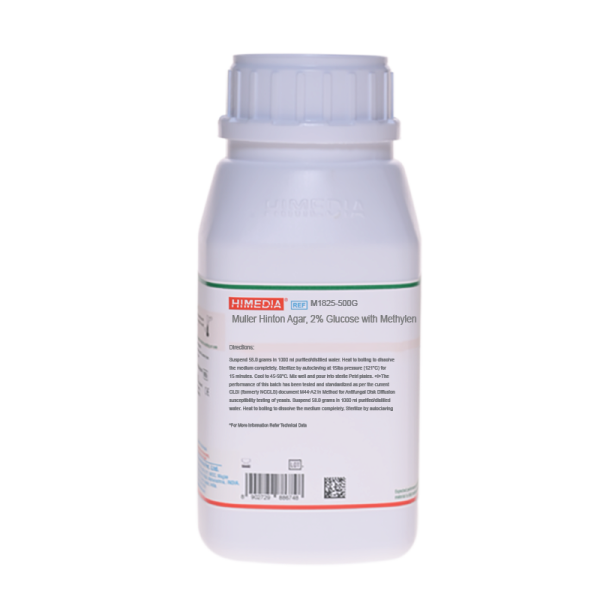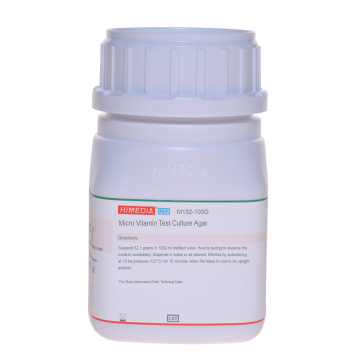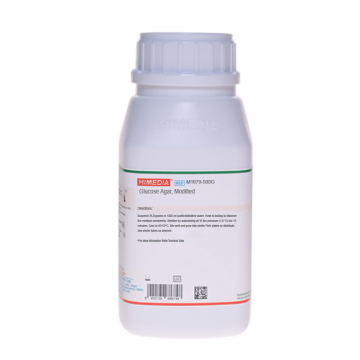 Your enquiry has been submitted
Your enquiry has been submitted
Mueller Hinton Agar 2% Glucose w/ Methylene blue
Intended Use
Recommended for performing antifungal disc diffusion susceptibility of yeasts.
Composition**
| Ingredients | g / L |
|---|---|
| HM infusion B # | 2.000 |
| Acicase™ | 17.500 |
| Starch | 1.500 |
| Dextrose (Glucose) | 20.000 |
| Methylene blue | 0.0005 |
| Agar | 17.000 |
Final pH ( at 25°C) 7.3±0.1
**Formula adjusted, standardized to suit performance parameters
# Equivalent to Beef Infusion from
Directions
Suspend 58.0 grams in 1000 ml purified/distilled water. Heat to boiling to dissolve the medium completely. Sterilize by autoclaving at 15lbs pressure (121°C) for 15 minutes. Cool to 45-50°C. Mix well and pour into sterile Petri plates.
The performance of this batch has been tested and standardized as per the current CLSI (formerly NCCLS) document M44-A2 in Method for Antifungal Disk Diffusion susceptibility testing of yeasts.
Principle And Interpretation
The Mueller Hinton formulation was originally developed as a simple, transparent agar medium for the cultivation of pathogenic species (1). Mueller Hinton Agar, Modified (as per CLSI for antifungal) is recommended for the diffusion of antifungal agents impregnated on paper disc through an agar gel as described in CLSI Approved Standard (2). When supplemented with glucose to a final concentration of 2%, it provides for suitable fungal growth. The addition of methylene blue to a final concentration of 5µg/ml enhances zone edge definition.
Kirby-Bauer et al recommended Mueller Hinton Agar for performing antibiotic susceptibility tests using a single disc of high concentration (3). WHO Committee on Standardization of Susceptibility Testing has accepted Mueller Hinton Agar for determining the susceptibility of microorganisms because of its reproducibility (4). Mueller Hinton Agar with 5% sheep blood and Mueller Hinton Agar with Haemoglobin have been recommended for antimicrobial susceptibility testing of Streptococcus pneumoniae and Haemophilus influenzae. Similarly Mueller Hinton Agar, Modified (as per CLSI for antifungal) is recommended for antifungal susceptibity testing of discs.
HM infusion B and Acicase™ provide nitrogenous compounds, carbon, sulphur and other essential nutrients. Starch acts as a protective colloid against toxic substances present in the medium. Starch hydrolysis yields dextrose, which serves as a source of energy. Dextrose (Glucose) serves as an energy source for fungal cultures while Methylene blue enhances zone edge definition.
Technique
Preparation of Inoculum:
- Inoculum is prepared by picking five distinct colonies of approximately 1mm from 24 hours old culture grown on Sabouraud Dextrose Agar (M063) and incubated at 35 ± 2°C. Colonies are suspended in 5ml of sterile 0.85% Saline.
- Vortex the resulting suspension and adjust the turbidity to yield 1 x 106 - 5 x 106 cells /ml (i.e. 0.5 McFarland standard).
Test Procedure:
- Prepare plates with Mueller Hinton Agar, Modified (as per CLSI for antifungal) for carrying out susceptibility of antifungal discs. The medium in the plates should be sterile and have a depth of about 4 mm.
- Dip a sterile non-toxic cotton swab on a wooden applicator into the standardized inoculum (turbidity so adjusted, as to obtain semi confluent growth on the Petri plate) and rotate the soaked swab firmly against the upper inside wall of the tube to express excess fluid. Streak the entire agar surface of the plate with the swab three times, turning the plate at 60° angle between each streaking. Allow the inoculum to dry for 5-15 minutes with lid in place.
- Apply the discs using aseptic technique. Deposit the discs with centers at least 24 mm apart. (Not more than 12 discs should be placed on a 150-mm plate or not more than 5 discs on a 100-mm plate.
- Invert the plates and place in an incubator set to 35 ± 2°C within 15 minutes after the discs are applied.
- Examine each plate after 20 - 24 hours of incubation. If plate was satisfactorily streaked the resulting zones of inhibition will be uniformly circular and there will be a semi-confluent lawn of growth. Read at 48 hours only when insufficient growth is observed after 24 hours incubation.
Type of specimen
Isolated Microorganism from clinical samples.
Specimen Collection and Handling
For clinical samples follow appropriate techniques for handling specimens as per established guidelines (5,6). After use, contaminated materials must be sterilized by autoclaving before discarding.
Warning and Precautions
In Vitro diagnostic Use only. For professional use only. Read the label before opening the container. Wear protective gloves/protective clothing/eye protection/face protection. Follow good microbiological lab practices while handling specimens and culture. Standard precautions as per established guidelines should be followed while handling clinical specimens. Safety guidelines may be referred in individual safety data sheets.
Limitations
- This medium is recommended for susceptibility testing of pure cultures only.
- Inoculum density may affect the zone size. Heavy inoculum may result in smaller zones or bigger zones.
- Fastidious organisms may not grow on this medium due to nutritional variations.
- Antifungal disc are used to carry out the susceptibility, proper storage of the disc is desired of the disc.
- Under certain circumstances, the in vitro results of antifungal susceptibility may not show the same in vivo.
Performance and Evaluation
Performance of the medium is expected when used as per the direction on the label within the expiry period at recommended temperature.
Quality Control
Appearance: Light yellow to yellow may have slight blue tinge homogeneous free flowing powder
Gelling: Firm, comparable with 1.7% agar gel.
Colour and Clarity of prepared medium: amber coloured clear to slightly opalescent gel forms in Petri plates
Reaction: Reaction of 5.8% w/v aqueous solution at 25°C. pH : 7.3±0.1
pH: 7.20-7.40
Cultural response: A luxuriant growth of test organisms was observed on Mueller Hinton Agar, Modified (as per CLSI for antifungal) in 24-48 hours at 33-37°C along with inhibition zones with respective antibiotic concentrations
| Organism | Inoculum (CFU) | Growth | Recovery | Amphotericin-B AP(100units) | Amphotericin-B AP(20 mcg) | Amphotericin-B AP(50 mcg) |
|---|---|---|---|---|---|---|
| Candida albicans ATCC 90028 | 50-100 | luxuriant | >=70% | 10 -17 mm | 10 -15 mm | 31- 42 mm |
| Candida parapsilosis ATCC 22019 | 50-100 | luxuriant | >=70% | 11 -20 mm | 10 -17 mm | 28 -37 mm |
| Candida tropicalis ATCC 750 | 50-100 | luxuriant | >=70% | 8 -12 mm | 8 -10 mm | 13 -17 mm |
| Candida krusei ATCC 6258 | 50-100 | luxuriant | >=70% | 9 -14 mm | 8 -12 mm | 16 -25 mm |
| Candida albicans ATCC 10231 (00054*) | 50-100 | luxuriant | >=70% | 10 -18 mm | 10 -16 mm | 30 -40 mm |
| Saccharomyces cerevisiae ATCC 9763 (00058*) | 50-100 | luxuriant | >=70% | 11 -18 mm | 8 -12 mm | 29 -38 mm |
Key : (*) Corresponding WDCM numbers.
Storage and Shelf Life
Store between 10-30°C in a tightly closed container and the prepared medium at 20-30°C. Use before expiry date on the label. On opening, product should be properly stored dry, after tightly capping the bottle in order to prevent lump formation due to the hygroscopic nature of the product. Improper storage of the product may lead to lump formation. Store in dry ventilated area protected from extremes of temperature and sources of ignition. Seal the container tightly after use. Product performance is best if used within stated expiry period.
Disposal
User must ensure safe disposal by autoclaving and/or incineration of used or unusable preparations of this product. Follow established laboratory procedures in disposing of infectious materials and material that comes into contact with clinical sample must be decontaminated and disposed of in accordance with current laboratory techniques (5,6).
Reference
- Mueller J. H. and Hinton J., 1941, Proc. Soc. Exp. Biol. Med., 48:330.
- Method for Antifungal Disk Diffusion Susceptibilty Testing of yeasts; Approved Guideline Second Edition M44-A2 Vol.24 No.17.
- Bauer A. W., Kirby W. M., Sherris J. L. and Turck M., 1966, Am. J. Clin. Pathol., 45:493.
- Present Status and Future Work, WHO Sponsored collaborative study, Chicago, Oct. 1967.
- Isenberg, H.D. Clinical Microbiology Procedures Handbook 2nd Edition.
- Jorgensen, J.H., Pfaller, M.A., Carroll, K.C., Funke, G., Landry, M.L., Richter, S.S and Warnock., D.W. (2015) Manual of Clinical Microbiology, 11th Edition. Vol. 1.
| Product Name | Mueller Hinton Agar 2% Glucose w/ Methylene blue |
|---|---|
| SKU | M1825 |
| Product Type | Regular |
| Physical Form | Powder |
| Origin | Animal |
| Packaging type | HDPE |
| References | 1. Allen. E.K. and Allen. O.N., 1950, Bacteriol. Rev., 14:273. |
| Customized Product Available | No |







